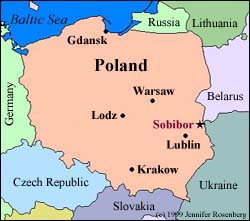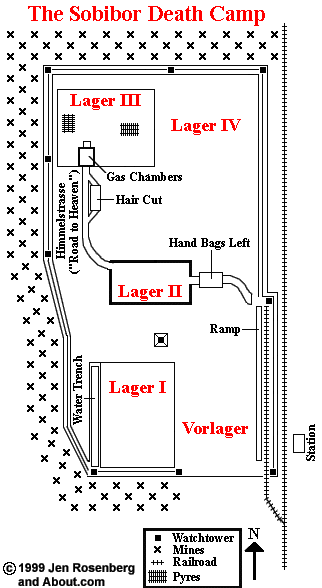| Sobibor was
established in March 1942. It was located in eastern Poland in an area
called Lublin. It got its name from a nearby village called Sobibor. The
Nazis chose its location because of the general isolation and its
proximity to a railway. Sobibor was built as part of the Reinhard
Operation. It was second of three camps built.
|

This is were Sobibor could be located |
The camp was
designed as a 400 by 600 meter rectangle. The camp had barbed wire fence
with tree branches in it to disguise the camp. The fence was three
meters high and the camp was nearly surrounded by a minefield. The camp
was originally built with three sections. In summer 1943 a fourth was
built. Sobibor was in operation for eighteen months and killed about
250,000 men, women, and children. About 1000 Jews worked there but only
about 48 prisoners survived the war. The fence was three
meters high and the camp was nearly surrounded by a minefield. The camp
was originally built with three sections. In summer 1943 a fourth was
built. Sobibor was in operation for eighteen months and killed about
250,000 men, women, and children. About 1000 Jews worked there but only
about 48 prisoners survived the war.
|
| SS officer Richard
Thomalla started construction on Sobibor but was replaced by SS officer
Stangl after 1 month. Stangl finished construction and became the first
camp commandant. In August 1942 SS officer Franz Reichsleitner replaced
Stangl as camp commandant.
|
The sections were
the Vorlager, Lager I, Lager II, Lager III, and Lager IV. The Vorlager
contained a ramp from the railroad tracks, SS housing, Ukrainian guard
housing, an armory, SS kitchen, and the bakery. Lager I was used for
barracks for the prisoners and workshops like a tailor, shoemaker,
carpenter, and mechanic. Lager II was where the new arrivals were
stripped of their possessions and clothing. It also processed the
objects taken from the new arrivals. Lager III had the gas chambers and
pyres for burning the dead bodies. It also contained housing for
prisoners working in Lager III. Lager IV was built in summer 1943 and
contained warehouses to store captured ammunition.
|

This is what the Sobibor train station looked like |
| The SS officers
were very dangerous and even more dangerous when they got bored.
Sometimes they shot prisoners for no reason. When they got bored they
would create games to torture the prisoners. One was when they would sew
up a prisoner's pant legs and put rats in their pants. Another was when
they forced thin prisoners to quickly drink vodka and then eat several
pounds of sausage. After that the SS officers forced their mouths open
and urinated in the prisoners mouths and laugh as they threw up.
|
| The first wave of
Jews came in July 1942. They came from Lublin, Poland, Czechoslovakia,
Germany, and Austria. 90,000 to 100000 Jews died in that wave. The
second wave of prisoners came June 1943. 70000 to 80000 Jews came from
Lublin and the Eastern Galica districts. 145000 to 150000 Jews came from
the General Gouvernement. 4000 Jews came from France and 35000 from the
Netherlands.
|
| The Jews were
treated differently depending on whether they came from the East or the
West. If they were from the east they came on cattle cars and were
beaten and yelled at. If they were from the west they came in their best
clothes and thought that they were being resettled in the east.
After they got off the cars, they were separated into two lines. One
line was for the men and one for the women and children. After that the
SS officers chose people at random to work. The ones that weren't picked
were sent to the gas chambers.
|
| The gas chambers
were found in a brick building containing chambers. Each chamber was
about 16 meters in size and capable of holding 200 people. A 200
horsepower engine in a nearby shed produced the gas. The engine produced
carbon monoxide gas. In 1942 three more chambers were added. Burial
trenches were nearby the gas chambers. Each trench was 50 to 60 meters
long, 10 – 15 meters wide, and 5 – 7 meters deep.
|
| The first test
occurred about mid-April where about 250 Jewish women from Krychow were
killed. The entire SS contingment attended this test.
|
| On July 5, 1943
Himmler ordered the camp to be closed as an extermination camp and
opened as a concentration camp. Lager IV was also built in this time to
store captured ammunition.
|
| In the summer and
fall of 1943 less transports started to come. Rumors started to spread
that the Nazis wiped Jewish from Europe. After that Leon Feldhendler
decided that the camp should try to escape. They needed a leader with
military and leadership experience. On September 23, 1943 Leon's
person arrived. It was First Lieutenant Alexander "Sasha"
Pechersky with a few of his men. Sasha was captured October 1941 near
Viazma and after being transferred from camp to camp he found out that
he had some Jew in him.
|
| On September 29th
Sasha and Feldhender met. Feldhendler had to convince Sasha that the
whole camp should escape and not just a few. So the two started to plan
using Shlomo Leitman to deliver messages to not draw attention to them.
The first plan was to dig a tunnel
under the fences and the minefield in the carpentry shop. But that plan
was ruined on October 8th and 9th due to heavy rain. So the second plan
was to make knives and hatchets in the workshops. Sasha's men started to
kill SS men but on the day of the revolt October 13th more SS men
arrived. The revolt was then postponed till the next day October 14.
|
| After the war
eleven SS men from Sobibor were captured and trialed in Hagen, West
Germany. The trial lasted from September 6, 1965 to December 20, 1966.
One committed suicide, one sentenced life in prison, five given
sentences for three to eight years, and four found innocent.
|
| Sobibor was one of
the Nazis best kept secrets. Very few people knew of Sobibor so that
Sobibor survivors were told that they had a big imagination. Some people
think that the secret of Sobibor was too successful.
|